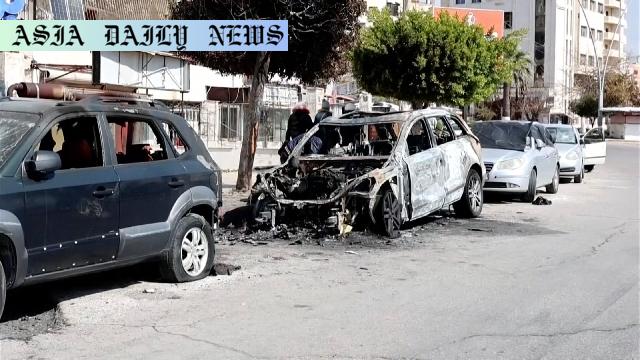Syria, monitoring groups report that over 1,000 civilians, including women and children, have been killed in the ongoing clashes.
Syria death toll surpasses 1,000 amidst ongoing clashes.
Alawites and civilians, including women and children, affected.
Violence impacts Latakia in Syria’s northwestern territories.
Military operations declared successful despite looting reports.

Escalating Death Toll and the Impact on Syria
The ongoing conflict in Syria has reached another grim milestone, with over 1,000 civilian deaths reported by the Syrian Observatory for Human Rights. The violence stems from clashes between interim government forces and factions loyal to former president Bashar al-Assad. Women and children constitute a significant portion of the casualties, underscoring the profound impact on vulnerable populations. The northwestern region of Latakia has been a critical hotspot for hostilities, which initially erupted last Thursday and have since spread to other parts of the country.
Tragically, many of the victims belong to the Alawite community, a minority group to which former President Assad himself belongs. This development has deepened the sectarian divides that continue to plague the nation. Moreover, reports indicate that over 480 militants from both sides have also lost their lives in these clashes, highlighting the scale and ferocity of the violence.
Government Claims and Contrasting Realities
On Monday, a spokesperson from the interim government’s defense ministry declared that their military operation had achieved all its objectives. However, this optimistic statement appears to contrast sharply with reports from the ground. The Syrian Observatory for Human Rights reported continued looting and chaos in affected areas, suggesting that the conflict’s aftermath remains unresolved. Such activities not only exacerbate the humanitarian crisis but also hinder the nation’s recovery and development.
Interim President Ahmed al-Sharaa attempted to reassure the public, stating that Syria would not allow foreign or local parties to drag the country into chaos or civil war. While these sentiments express hope for unity and peace, the prevailing realities paint a bleaker picture. The statement also solidifies the interim government’s position amidst questions about its ability to stabilize the nation effectively.
The Human Cost: Civilians Caught in the Crossfire
Perhaps the most devastating consequence of these clashes is the toll on civilians. With over 1,000 lives lost, including numerous women and children, the human cost is staggering. For many families, the violence has brought unimaginable grief, as homes and livelihoods have been destroyed or stolen amidst the conflict. Meanwhile, the continued looting and instability further compound these losses, leaving survivors with little hope for rebuilding their lives.
International organizations and humanitarian groups face significant challenges as they attempt to provide aid to those in need. Access to regions like Latakia is often restricted, and the volatile situation makes delivering assistance a perilous endeavor. The ongoing violence disrupts the lives of millions who already live in a state of precarity due to Syria’s protracted conflict.
A Call for International Attention and Support
The worsening situation in Syria underscores the urgent need for international attention and support. Despite global efforts to bring resolution to the conflict, the latest reports indicate worsening conditions that demand immediate action. The international community must engage with Syrian leadership while also providing aid to civilians caught in this devastating crisis.
Syria’s future depends on the collective effort of both its interim leaders and global stakeholders to bring about peace, stability, and sustainable recovery. Continued neglect risks further destabilization, potentially leading to deeper political, social, and humanitarian challenges.
Commentary
Reflecting on Syria’s Grim Milestone
The news of over 1,000 civilian deaths in Syria’s recent clashes is both heartbreaking and alarming. The situation lays bare the devastating toll of prolonged conflict and the fragility of peace in a region marred by years of war. As civilians bear the brunt of this violence, the question arises—how much longer can this suffering continue before decisive action is taken?
Civilians Pay the Heaviest Price
Women, children, and marginalized communities like the Alawites are caught in the crossfire, and their suffering highlights the human cost of political and sectarian conflicts. It is especially unsettling to see how vulnerable populations are left to endure systematic violence while global attention waxes and wanes. Stories of grief, loss, and upheaval deserve more than momentary acknowledgment; they demand sustained international commitment to alleviate their suffering.
The Role of Syria’s Leadership and the Global Community
Interim President Ahmed al-Sharaa’s statements convey an optimism that appears out of sync with realities on the ground. While maintaining national unity and avoiding chaos are noble aspirations, words must be backed by decisive actions that address the root causes of instability. The global community’s role cannot be overstated, as collaboration between Syrian leadership and international organizations offers the clearest path forward.
Hope Amid Despair
Amidst the devastation, hope must remain alive. Syria’s people deserve a future free from violence and chaos, where they can rebuild their lives with dignity. However, achieving this vision will require not only domestic reforms but an unprecedented level of international collaboration, transparency, and long-term commitment to peacebuilding and humanitarian efforts.


